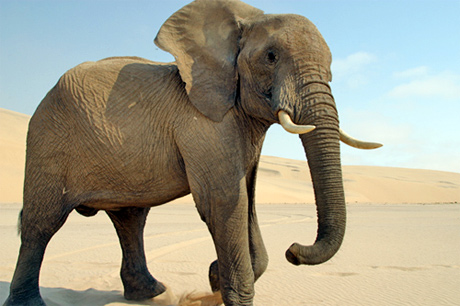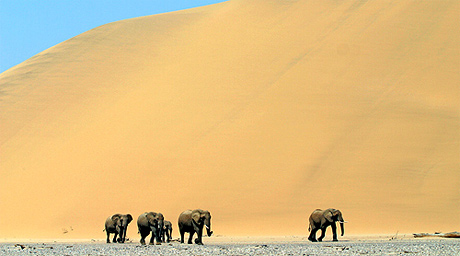

Our Programmes |
Eye for an Elephant The Story Told in the Film
AN EYE FOR AN ELEPHANT charts the journeys Colbeck has made since he first became entranced by the magic and mystery of elephants after he arrived in Amboseli National Park in 1990 and met Echo, a young matriarch. His work on an eventual trilogy about Echo and her family resulted in scenes of elephant life and behaviour never seen on screen before - and inspired him to seek out and film other herds, including the forgotten elephants who struggle for survival in the parched deserts of Namibia and the dense confines of the Congolese jungle. The story of his personal and wildlife discoveries is told by inter-cutting new footage and Colbeck’s recollections with archive treasures and a selection of the powerful still images that helped him to win the title International Wildlife Photographer of the Year. As the story unfolds, viewers experience the intensity of the camerman’s relationship with the elephants he views almost as family, and gain a sense of why they deserve his affection.
For production stills/ preview tapes: Jo Avery, BBC NHU, tel: +44 (0)117 974 6816; jo.avery@bbc.co.uk
About Martyn Colbeck
Martyn Colbeck is an award-winning film-maker and photographer who has been photographing wildlife for over 20 years. His career started in 1980 since when he has travelled the globe filming wildlife, much of it rare or endangered. His work includes sequences for many of the BBC Natural History Unit’s best-known blockbuster series plus award-winning independent films. In 2000, he won the award for best cinematography at the prestigious international Wildscreen festival with ELEPHANTS OF THE SAND RIVER, about the desert elephants of Namibia. In 2003, he was voted Best Cinematographer again, at the Jackson Hole festival, US, for Wild Africa: "Mountains". He is also a past winner of the world’s biggest and best respected wildlife photography competition: Wildlife Photographer of the Year, winning the overall title in 1993, the Gerald Durrell Award for the best depiction of endangered wildlife in 1996 and two further awards for black and white images in 2005. Click here to see some of Martyn's pictures Martyn Colbeck quotes from the film
About elephants The African elephant is the largest living land mammal. An adult male on the Kenyan plains may weigh as much as 12,000 pounds (5,450 kilos) and stand over 10 feet (3 metres) tall at the shoulder. Elephants adopt the same intricate social patterns wherever they live. This includes living in extended families, headed by an older female (the matriarch) and mostly comprising other females and their young. Males leave the herd at around 14, either to range alone, or to live in ‘bachelor herds’, only rejoining the females to mate. Females may continue calving until they are around 50 and the animals can live to be 70 - if they escape hunger, serious injury or poachers. Ivory poaching and habitat loss means puts elephants worldwide under threat. In 1970, Africa’s wild population was estimated at three million; recent counts set the total below 700,000. Martyn Colbeck’s photography provides many fascinating insights into elephant life and behaviour, much of it previously unrecorded. Rare or hitherto unseen sequences include family members persuading a disabled calf to walk, a mother lifting and carrying a premature baby, grief over the death of family member, play and a greeting ceremony.
|



